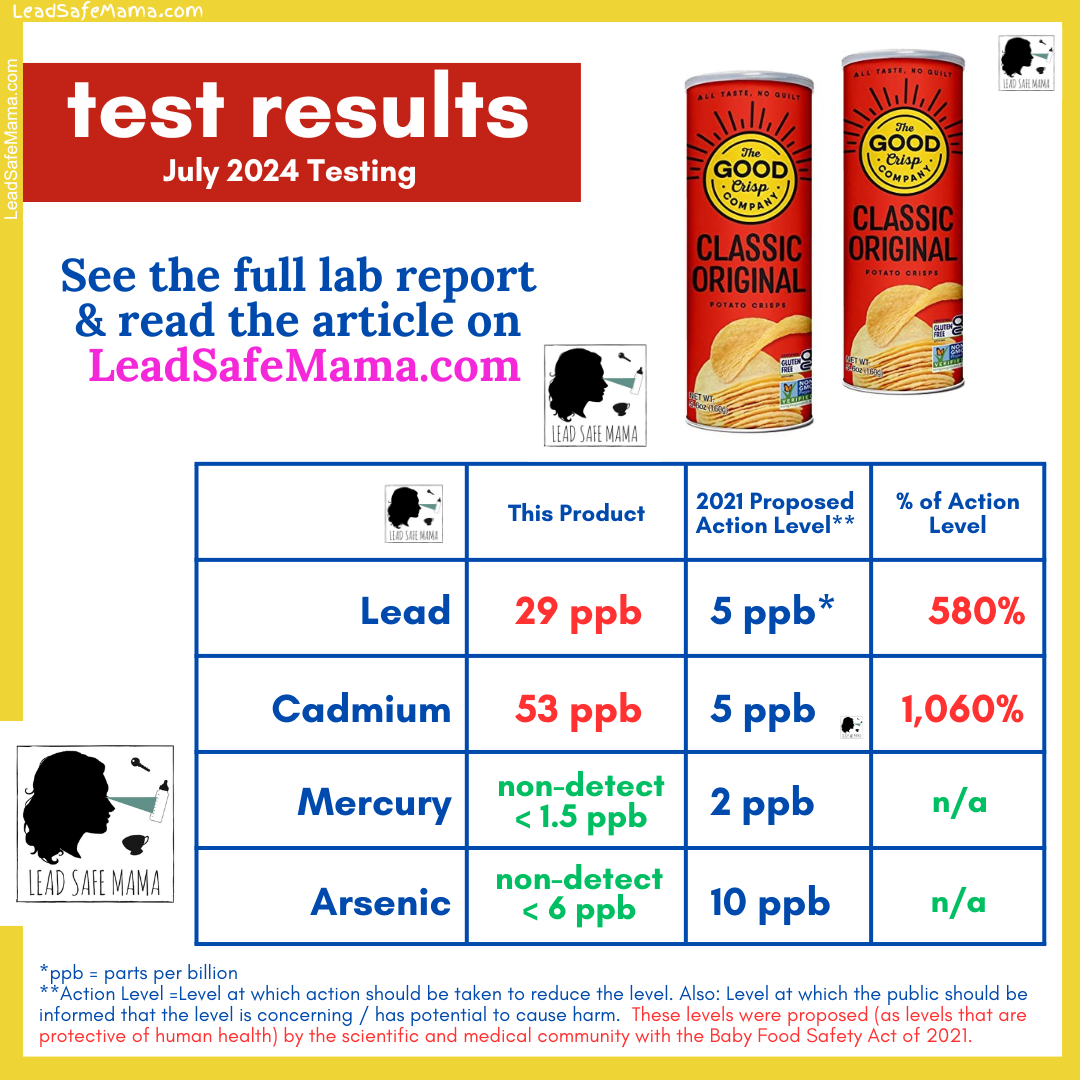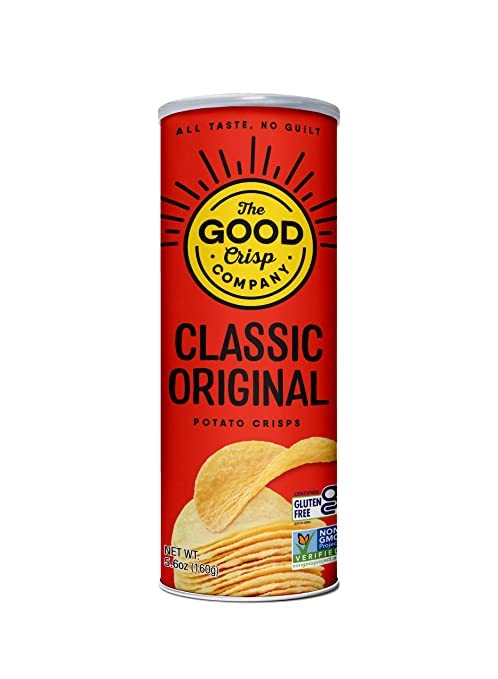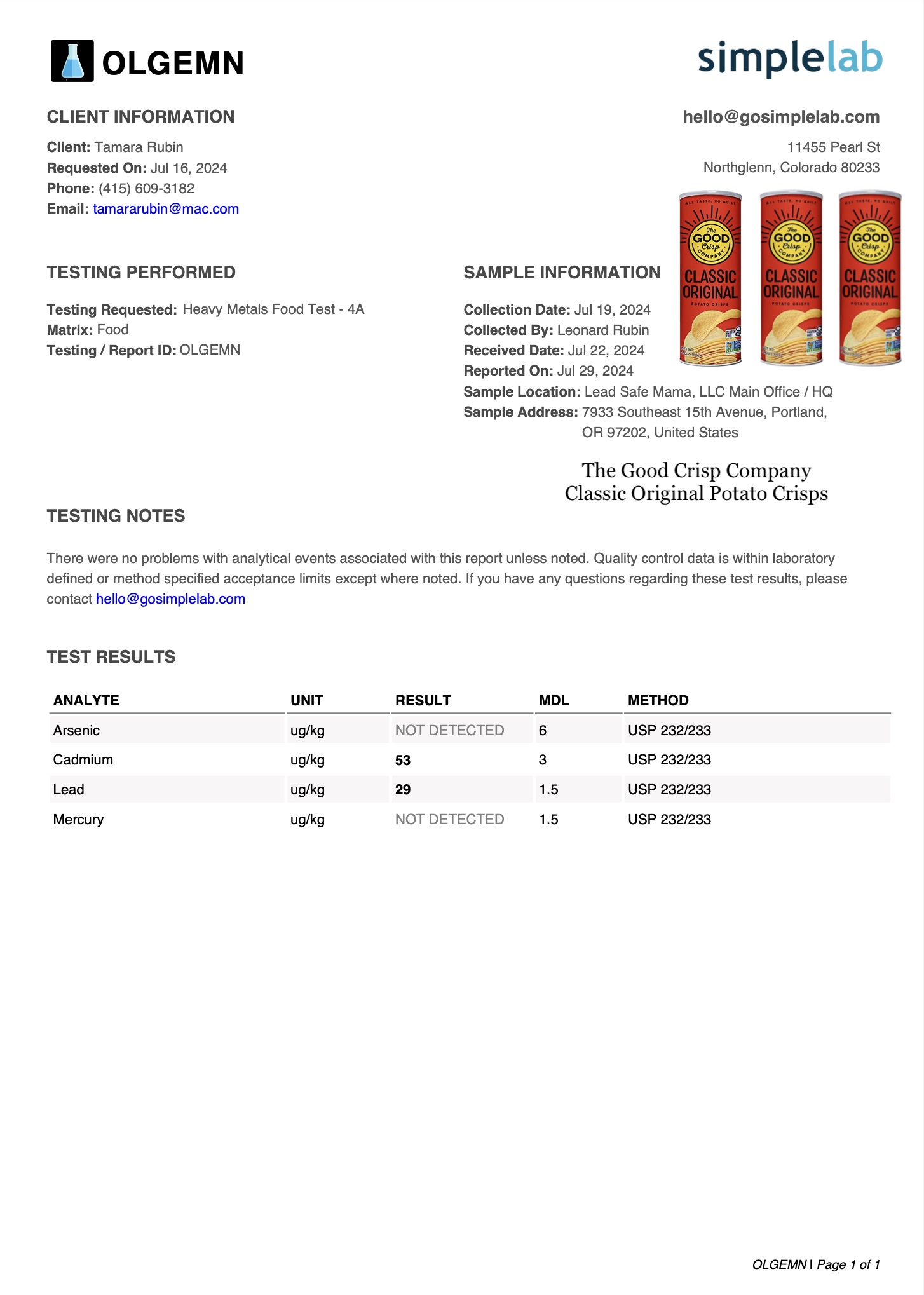The Good Crisp potato chips in Classic Original flavor test positive for unsafe levels of Lead and Cadmium. Read the July 2024 lab report here.
For those new to the Lead Safe Mama website:
Tamara Rubin is a multiple-federal-award-winning independent advocate for childhood Lead poisoning prevention and consumer goods safety, and a documentary filmmaker. She is also a mother of Lead-poisoned children (two of her four sons were acutely Lead-poisoned in 2005).
- Tamara owns and runs Lead Safe Mama, LLC — a unique community collaborative woman-owned small business for childhood Lead poisoning prevention and consumer goods safety.
- Since July of 2022, the work of Lead Safe Mama, LLC has been responsible for six product recalls (FDA and CPSC).
- All test results reported on this website are science-based, accurate, and replicable.
- Please check out our press page to see some of the amazing coverage of our work so far this year!

This is an ad-free article.
Advertising and affiliate income help Lead Safe Mama, LLC cover the costs of the work we do here (independent consumer goods testing and childhood Lead poisoning prevention advocacy). We have removed ads from most of our more widely-read articles (and newly published articles, too — like this one!) to make them easier for you to read. In addition to supporting this work by starting any shopping you might be doing with a click on our affiliate links, if you would like to support the independent consumer goods testing and childhood Lead poisoning prevention advocacy work of Lead Safe Mama, LLC by making a contribution (which will also help us keep our more widely-read articles ad-free), click here. Thank you!
Important Background: What is an Action Level?
Please note the following key points:
The original lab report for this product is below (at the bottom of this page).
The graphic above shows the levels of metals detected in this product (in red) along with the low threshold of detection (in green) for each of the metals not detected with the laboratory testing Lead Safe Mama, LLC completed for this product. The numbers are juxtaposed (in blue) to the “Action Level” proposed by the medical and scientific community in 2021 as part of the Baby Food Safety Act.
- These 2021 levels were proposed as “Action Levels” because they are (in fact) protective of human health.
- An “Action Level” is NOT the same as a “Maximum Allowable Level.”
- Many food manufacturers misinterpret guidance on heavy metals to mean “allowable levels” and consider it reasonable for their products to test positive below these levels.
- This is a (perhaps intentional?) misunderstanding/ misinterpretation the food industry makes — a misunderstanding that food manufacturers use to justify the presence of heavy metals in their products.
- There is no safe level of Lead exposure.
- Lead bioaccumulates in the body.
- Lead bio-mimics Calcium in all biological structures.
- If Lead is present, the human body stores it in Calcium-dense biological structures (the brain, bones, organs, teeth, etc.) in place of Calcium.
- Nearly all the Lead you have been exposed to in your life is still stored in your body. You can learn more about this by watching our documentary film on childhood Lead poisoning — linked here.
- It is the cumulative impact of heavy metal exposure (over a lifetime) that makes even small/ incidental/ seemingly trivial exposures particularly damaging and dangerous. You can read more about that here.
- Once a food product has the amount of heavy metal (Lead, Cadmium, Mercury, or Arsenic) noted (above) as the “Action Level,” that food product is officially considered (by the scientific and medical community) unsafe for consumption by children as toxicants (found at-or-above these levels) are in the range of heavy metal levels that have been demonstrated to cause lasting harm.
- Action Levels are not related to serving size.
- Action Levels are relevant for any amount of a food product that may be consumed (any quantity of the food in question).
- PPB (parts per billion/ ppb) measurements are a percentage (albeit a very small percentage) and apply to any quantity of the food product tested.
- For more discussion about serving size considerations (and why relying on “serving size” to limit toxicant exposure is not a relevant metric/ not a metric protective of human health), read this article.
- These “Action Levels” proposed in 2021 are the levels at which the scientific and medical community believe the manufacturer (or government) needs to take ACTION to fix the problem.
- One “Action” would be for the manufacturer to take steps to reduce the levels of toxicants in the food product.
- Another “Action” would be for the manufacturer to cease sales of the product until the product could be made safe.
- Another “Action” would be for the manufacturer to inform the public that a specific food product has an unsafe level of the metal detected at-or-above the “Action Level” — making a highly-visible public announcement regarding which relevant batches of the product should be recalled/ no longer consumed.
- The Action Levels proposed with the Baby Food Safety Act of 2021 were not arbitrary toxicant levels, but were proposed because they are the levels most protective of human health. The Baby Food Safety Act of 2021 was, however, not passed into law.
- Regardless of the fact the Baby Food Safety Act of 2021 never passed into law — and it is therefore legal to have food for children test positive for Lead, Cadmium, Mercury, and Arsenic at-or-above these levels — these Action Levels still reflect the current (modern/ relevant) advice of the medical and scientific communities as levels both achievable by the industry and safeguards of infant and toddler health.
- Food industry lobbyists fought against formalizing these proposed “Action Levels” as a government standard, alleging they were unachievable.
- The image below (with the number SIX) links to a landing page with 6 food products we have already tested this year (2024), all of which have been “non-detect” for toxicants with low thresholds of detection (for Lead, Mercury, Cadmium, and Arsenic) far below the 2021 proposed Action Levels.
- These SIX food products (about 10% of the foods Lead Safe Mama, LLC has tested and reported on so far since March of 2024, when we started laboratory testing foods) clearly demonstrate these Action Levels as achievable across a range of food types (salt, flour, coffee, oatmeal, chia seeds, and a soda product — plus we are always adding more to that list every month).
- The legitimacy of these levels as “Action Levels”/ “Levels of Concern” (even though they were not adopted as law) is further mirrored by the legitimacy of the America Academy of Pediatrics’ level of concern for Lead in water, which is 1 ppb despite the FDA’s official “level of concern” for Lead in water set at 15 ppb (you can read more about that here).
For safer snack ideas, click here.
Lead Safe Mama, LLC Lab-Tested Safer Choices List
Below is an expanding list of products (foods, supplements, cosmetics, and personal care items, including sunscreens and toothpaste) that tested “non-detect” for Lead, Mercury, Cadmium, and Arsenic with independent, third-party, community-funded laboratory testing coordinated by Lead Safe Mama, LLC (an Oregon-based small business with a unique community-collaborative business model and a focus on consumer goods safety and childhood Lead poisoning prevention). The product examples below clearly demonstrate that companies can manufacture safer choices (at least from the perspective of a concern for heavy metals contamination).
–
The limits of detection (low-threshold of detection) for each of the metals tested are noted in the lab report for the specific product listed. To see the full original lab report for any of these products, type the brand name into the search bar at the top of any page on Lead Safe Mama dot com (and scroll down to the bottom of the related article). All our published lab reports are also linked here, on our lab testing landing page.
–
Flavors (or specific variations) tested are noted, and other variations of the same product (or other products from the same brand) have either not been tested or have been tested but did not yield similar results. Test results only apply to the specific products listed and linked below.
Products on our “safer choices” list are retested periodically (annually or more frequently, as funding permits). If a product no longer tests clean, it is removed from the list.
Lab-Tested Safer Choices List
UPDATED: August 2, 2025, Saturday
Now at 77 products + 6 “bonus” options. Scroll down to see all 83 products:
- Baby Food — 1 — Little Spoon Kale, Carrot + Pear BabyBlends
- Baby Food — 2 —Little Spoon Butternut Squash + Blueberry BabyBlends
- Baby Food — 3 — Little Spoon Sweet Potato BabyBlends
- Baby Food — 4 — Little Spoon Sweet Potato + Carrot BabyBlends
- Baby Food — 5 — Little Spoon Banana + Pitaya BabyBlends
- Beverage — 1 — Honest Kids Organic Appley Ever After Apple Juice Drink: https://amzn.to/4fjGhov
- Beverage — 2 — Olipop Grape Tonic: https://amzn.to/4cjFYZu
- Beverage — 3 — Synergy Golden Pineapple Kombucha: https://amzn.to/3HVzMgM
- Breakfast Cereal — 1 — Nature’s Path Envirokidz Organic Panda Puffs: https://amzn.to/4fo1crf
- Breakfast Cereal — 2 — Nature’s Path Envirokidz Organic Corn Puffs Gorilla Munch: https://amzn.to/3FHZCDO
- Candy — 1 — Cavendish & Harvey Wild Berry Drops, not organic (Made in Germany): https://amzn.to/3Z1Jxjr
- Candy — 2 — Haribo Gummy Bears (Made in Germany, not USA-produced): https://amzn.to/3FCGVlu
- Candy — 3 — Lindt White Chocolate Bar (Made in USA, New Hampshire): https://amzn.to/3OXkyIm
- Candy — 4 — Werther’s Original Butter Candies (Made in Germany, not USA-produced): https://amzn.to/4nkFc5i
- Coffee & Tea — 1 — Chameleon Handcrafted Organic Cold Brew Concentrate: https://amzn.to/3OcrH77
- Coffee & Tea — 2 — Tao of Tea Organic Genmaicha (Tamara’s favorite, Made in Japan, sold by a Portland, Oregon-based company!): https://amzn.to/3Dp8Fsd
- Coffee & Tea — 3 — Califia Farms Almond Latte Cold Brew (XX Espresso): https://amzn.to/4gTTGoJ
- Coffee & Tea — 4 — Death Wish Organic Espresso Roast Ground Coffee (Multi-country origin, non-USA): https://amzn.to/3yo1eiL
- Cosmetic— 1 — Babo Botanicals Sensitive Baby Lotion: https://amzn.to/3YmKxy1
- Cosmetic— 2 — Epaderm Lotion (for Psoriasis, European Product): https://amzn.to/4lXkyH5
- Cosmetic — 3 — Kora Organics Noni Face Oil: https://amzn.to/43hy2XO
- Cosmetic — 4 — Supergoop! Unseen Sunscreen, SPF 50 (chemical sunscreen, please read article): https://amzn.to/3HRMVrl
- Cosmetic — 5 — La Roche Posay Kids’s Sunscreen: https://amzn.to/3IP2i4b
- Dairy — 1 — (cheese) — Babybel Mini Original Snack Cheese: https://amzn.to/3ZY5noO
- Dairy — 2 — (coffee creamer) — Organic Valley Grassmilk Half and Half: https://amzn.to/4fHJIWT
- Fruit Snack — 1 — (bar) — Pure Organic Layered Fruit Bars in Raspberry Lemonade Flavor: https://amzn.to/3XcFsIp
- Fruit Snack — 2 — (bar) — Pure Organic Layered Fruit Bars in Strawberry Banana Flavor: https://amzn.to/3WQEekA
- Fruit Snack — 3 — (pouch) — Costco’s Kirkland Organic Apple Sauce Pouch: https://amzn.to/4gOYpZ9
- Fruit Snack — 4 — (pouch) — GoGo Squeez Organic Apple Sauce Pouch: https://amzn.to/3XhWYLe
- Fruit Snack — 5 — (pouch) — Once Upon A Farm Dairy-free Fruit Smoothie Pouch in Strawberry Banana Swirl Flavor: https://amzn.to/3CPMbAw
- Infant Formula — 1 — Bobbie Organic Gentle Infant Formula Milk-Based Powder with Iron (pink and white can): https://amzn.to/3YYb849
- Infant Formula — 2 — Bobbie Organic Infant Formula Milk-Based Powder with Iron (green and white can): https://amzn.to/3VOr4Vy
- Infant Formula — 3 — Bobbie Grass-Fed Milk-Based Powder with Iron (green can): https://amzn.to/3ZlAaeJ
- Infant Formula — 4 — ByHeart Infant Formula (USA-made, not organic): https://amzn.to/48DJjTb
- Infant Formula — 5 — HiPP Bio Combiotik Infant Formula Powder, Stage 1 (imported)
- Infant Formula — 6 — HiPP HA Stage PRE (0+ Months) Combiotic Formula (imported)
- Infant Formula — 7 — Holle Bio Goat Stage 2 Infant Formula (for 6-10 months, organic, European — Swiss/ German/ Austrian) is not available on Amazon, but the Stage 3 version of this product is (not yet tested, but will likely test similarly): https://amzn.to/3BVU7zI
- Infant Formula — 8 — Kendamil Goat Infant Formula (not organic): This product may be available at Target (it is not available on Amazon)
- Infant Formula — 9 — Kendamil Organic Follow-On Milk (European/ British Toddler Formula, for 6-12 months, Cow Milk): Not available on Amazon
- Infant Formula — 10 — Kendamil Whole Milk Infant Formula (from Europe, pink can, not organic), available at Target
- Infant Formula — 11 — Kendamil Organic Infant Formula (Cow Milk): Not available on Amazon but may be available at Target
- Ingredient — 1 — (baking flour) — Jovial Organic Einkorn Flour (Italy): https://amzn.to/3LIqxix
- Ingredient — 2 — (beans) — Jovial Organic Chickpeas, Product of Italy: https://amzn.to/4iRON1l
- Ingredient — 3 — (vinegar) — Napa Valley Naturals Organic Red Wine Vinegar (California): https://amzn.to/4jWhHOg
- Oil — 1 — (avocado) — Chosen Foods 100% Avocado Oil (not organic): https://amzn.to/3YDZSuv
- Oil — 2 — (coconut) — Dr. Bronner’s Regenerative Organic Coconut Oil: https://amzn.to/40xwBmv
- Oil — 3 — (olive) — Bryan Johnson BluePrint Snake Oil Olive Oil (not organic): https://amzn.to/4mMieUj
- Oil — 4 — (perilla seed) — Dr. Adorable’s Organic Perilla Seed Oil (Korea): https://amzn.to/3NDt7Yc
- Plant-Based Milk — 1 — (coffee creamer) — Laird Superfood Coconut Creamer: https://amzn.to/4fItA7A
- Plant-Based Milk — 2 — (plant milk) — Kiki Milk Organic Plant-Based Milk (original flavor): https://amzn.to/3AA6Qrt
- Plant-Based Milk — 3 — (soy milk) — West Soy Unflavored Unsweetened Organic Soy Milk: https://amzn.to/4dwev8l
- Salt — 1 — Jacobsen’s Sea Salt (Oregon, USA): https://amzn.to/4dcbk5L
- NEW! Salt — 2 — Maldon Sea Salt Flakes**: https://amzn.to/4iTzWTE
- NEW! Salt — 3 — Diamond Crystal Kosher Salt** : https://amzn.to/4cVQMiy
- Seeds — 1 — (chia) — Navitas Organic, Gluten-Free Chia Seeds (Mexico): https://amzn.to/3YvE7xC
- Seeds — 2 — (hemp) — Costco Kirkland Organic Hemp Seeds: https://amzn.to/4e05RP9
- Supplement — 1 — (adult) — Clean Creatine (100% Creapure), Made in Germany (use with caution, please read article): https://amzn.to/43UjrS6
- Supplement — 2 — (adult) — Doctor’s Best Vitamin C with Q-C: https://amzn.to/4hlVvea
- Supplement — 3 — (adult) — Nature’s Way Zinc Lozenges: https://amzn.to/4liDz6f
- Supplement — 4 — (adult) — Nordic Naturals Omega-3 Fish Oil: https://amzn.to/48q1j2V
- Supplement — 5 — (adult) — Pectasol Modified Citrus Pectin, Formulated in the USA: https://amzn.to/3QUmZfN
- Supplement — 6 — (adult) — Pendulum Metabolic Daily Dietary Supplement: https://amzn.to/4gY5wOm
- Supplement — 7 — (adult) — Qwell Omega-3 by The Veggie Doctor, Vegan Algae DHA + EPA + DPA: https://amzn.to/45Lbosh
- Supplement — 8 — (kids) — Baby Ddrops, Organic Vitamin D3 Supplement for Babies: https://amzn.to/49C3ktH
- Supplement — 9 — (kids) — Mary Ruth’s Organic Toddler Multivitamin Liquid Drops with Iron: https://amzn.to/3YPhcgx
- Supplement — 10 — (kids) — Mary Ruth’s Organic Toddler Elderberry Liquid Drops: https://amzn.to/42617TU
- Supplement — 11 — (kids) — Nordic Naturals Kids Vitamin D3 Gummies (Ages 3+): https://amzn.to/4l7117a
- Sweetener — 1 — (sugar) — Anthony’s Organic Granulated Cane Sugar: https://amzn.to/4jf6vLv
- Sweetener — 2— (xylitol) — Espure Organic Xylitol: https://amzn.to/3GsCSrU
- Sweetener — 3— (xylitol) — Now Real Food Granulated Xylitol: https://amzn.to/4cNWDpM
- Toothpaste — 1 — Aquafresh “FRESH & MINTY” Fluoride Toothpaste, Purchased in London, England (Made in U.K. or Slovakia): https://amzn.to/4lhRMjO
- Toothpaste — 2 — Orajel Kids Training Toothpaste, Fluoride-free in Natural Berry Fruity Flavor with Elmo Sesame Street packaging: https://amzn.to/41wxtrY
- Toothpaste — 3 — Miessence Fluoride-free Mint Toothpaste (Made in Australia): https://amzn.to/4bJc4PO
- Toothpaste — 4 — Dr. Brown’s Fluoride-free Baby Toothpaste in Strawberry Flavor: https://amzn.to/3DCehzZ
- Toothpaste — 5 — Pegciz Kids Foam Toothpaste in Watermelon Flavor, Low Flouride (packaging varies, see report): https://amzn.to/3YzP68e
- Toothpaste — 6 — Kid’s Spry Fluoride-free Tooth Gel with Xylitol in Original Flavor: https://amzn.to/41GZb4e
- Toothpaste — 7 — Essential Oxygen Fluoride-free BR Certified Organic in Peppermint Flavor: https://amzn.to/4lARZ2J
**Lab reports pending/ Not yet published as of 8/2/2025
Here’s a link to our landing page featuring all our third-party lab reports for the foods, supplements, and cosmetic products we have published to date, including those listed above. This is a good page to bookmark since it is updated several times each week, as new lab reports are published: https://tamararubin.com/lab-reports/
BONUS: Below are SIX additional products that each tested positive for trace (very low levels of) Arsenic — at levels considered safe by all standards (with the limits of detection noted in the lab report for the specific product listed).
- Infant Formula — Kendamil Goat Toddler Milk, not organic (positive for traces of Arsenic): May be available at Target or through other online retailers of European infant formulas
- Ingredient — Maseca Instant Corn Masa Flour, Product of Mexico (positive for traces of Arsenic): https://amzn.to/4iR8qWN
- Fruit Snack — That’s It Apple Cherry Bars, not organic (positive for traces of Arsenic): https://amzn.to/4fHkSWV
- Oil — Chosen Foods 100% Pure Avocado oil, organic (postive for traces of Arsenic): https://amzn.to/3BVQYQa
- Supplement — (adult) — Now Sunflower Lecithin, not organic (positive for traces of Arsenic): https://amzn.to/3AFdHzO
- Supplement — (adult) — WishGarden Immune Boost Seasonal Rescue for Pregnancy: https://amzn.to/3Cd940N
Published: August 16, 2024
Please scroll down to see the full lab report for the product pictured above.
Please do check out the other links on this page for additional information about the truly independent, third-party, laboratory testing we are conducting on food products.
As there are almost no reasonable safety thresholds proposed for toxicants (heavy metals) consumed by adults (in foods and supplements), our focus is (as always) on the health of children. The available proposed safety thresholds (and guidance) for foods consumed by adults are not set at levels protective of human health and are therefore irrelevant to the work we do here at Lead Safe Mama, LLC.
Amazon links are affiliate links. If you purchase something after clicking on a Lead Safe Mama, LLC Amazon affiliate link, Lead Safe Mama, LLC may receive a percentage of what you spend — at no extra cost to you.
Lab report for The Good Crisp potato chips in Classic Original flavor, as pictured:
Never Miss an Important Article Again!
Join our Email List









Hi Rubins, what are the ingredients, please? Do Good Crisps have cassava flour?
Thanks Myra
Thanks for commenting!
No Cassava in these. The contamination is most likely due to some step(s) in the processing of the potatoes
UGH this breaks my heart! On the occasion we indulge, these are our favorite chip! I don’t like salt and vinegar chips at all… is there an acceptable alternative?
Thanks for all you do Tamara!
Jeanne
We have not found ANY safe potato chip products yet.
T
I just got $60 worth of these from Thrive Market. Ugh
Yeah – I used to let my kids eat them. I thought they were “better” – we will no longer be purchasing these.
T
Is it from processing or the potatoes?
I think it may be – but we won’t know for sure without more testing (and without the company evaluating their manufacturing equipment).
T
Yea the first time I bought these for my husband quite some time ago I didn’t realize they had maltodextrin, even when shopping in a “healthy” store you still have to be careful. Thanks to that garbage I didn’t repeat the purchase